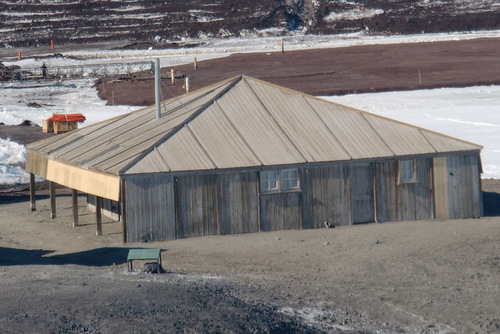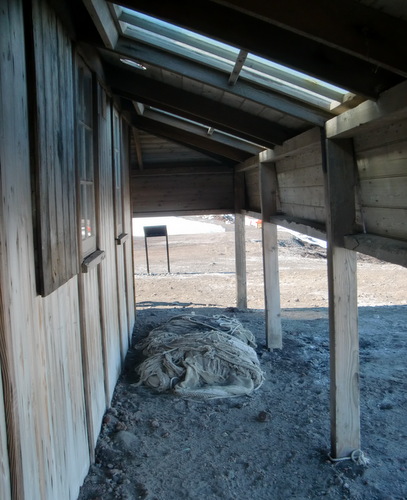Meet McMurdo: Hike to Discovery Hut

I’ve got ‘good’ news and ‘bad’ news.
Since I like to end things on a positive note, let’s start with the ‘bad’ news, first.
The ‘bad’ news… Our flight off the continent has been postponed, for several days. We will likely not leave until Saturday, at the earliest.
Now for the ‘good’ news…While I was looking forward to going home, I’m not too disappointed because I was not able to visit Discovery Hut. And now, because we have some ‘extra’ time, I’m able to make the hike.
So, are you up for another hike, today?
Let’s explore Hut Point. We’ll also learn a bit about Antarctica’s earliest explorers.
Hiking to Hut Point
It’s a beautiful day! Clear skies, light winds with a temperature of 28 degrees Fahrenheit (-2 degrees Celsius), which is a gorgeous day for McMurdo. Jenn, Greg, Amy, and I are ready for the adventure.
We decided to take the more exciting route and hiked the entire Arrival Heights trail. This loop is approximately 3 miles long and took us on a moderately hilly, rocky trail. And for you history buffs, the trail passes directly in front of Discovery Hut, which was built by Robert Falcon Scott and his team on their first expedition to Antarctica.

We walked along the main road, which has some fantastic views of the Sound, McMurdo Station and Observation Hill.
As we walked up to the entrance of the hut, I was reminded that it was constructed, like everything else here, atop volcanic rock!
Discovery Hut is now a museum, and as a museum worker myself, I was in awe of how eerily ‘frozen in time’ this place was. This made me wonder about Scott and his team.

A brief history of Robert Falcon Scott
At the beginning of the 20th century, Antarctica remained a virtually unexplored continent. The possibilities for scientific discovery and research there were unlimited! But that’s not what attracted Antarctica’s early explorers. They were more interested in being the first to reach the South Pole, which at the time was considered the last prize of geographical exploration. Britain’s Royal Geographical Society was eager to claim the South Pole for Great Britain. They planned an expedition with Robert Falcon Scott, The Royal Navy’s commander, as its leader. He didn’t reach the Pole, but he did travel further south than anyone ever had and was considered a hero. He would later make another attempt, and this time he made it to the South Pole; but he wasn’t the first. He was beaten by Roald Amundson, a Norwegian explorer. Though Scott and several members of his team reached their goal, they, sadly, died during the return trip.

Discovery Hut: McMurdo’s first building
Today, there are over 100 buildings at McMurdo Station. Scott’s Discovery Expedition constructed the very first building (built over 100 years ago), and it’s still standing today! The expedition and the hut were named after their ship, the Discovery, which set sail from London on July 31, 1901. There were 47 men aboard this ship, including men from the Royal Navy, the Royal Marine, the Merchant Navy, scientists, civilians and even several dogs! They arrived in McMurdo Sound in early February 1902. It only took me 4 days to get to McMurdo, but it took these explorers over 6 months!

Discovery Hut: prefab construction
The hut was what we would call today ‘prefab.’ It was designed and built in Australia. All of its pieces were carefully numbered and labeled before being taken apart and packed aboard the Discovery. When the expedition arrived, they rebuilt it where it stands today. It was made of Australian jarrah wood, and the design was typical of huts made for summer use in the Australian outback. Yes, I said summer use.
Can you think of any reasons why this might be a problem?

Huts in the Australian outback are constructed to be cooler on the inside than the outside, which is the exact opposite of what you want in Antarctica! And, Discovery Hut’s materials provided virtually no insulation. The hut was so cold that the crew couldn’t live in it. So, it was used to store their cargo, and they lived aboard their ship instead.
Discovery Hut: museum conservation project
The hut served as refuge for later research expeditions to Antarctica. It was last occupied in 1916, and it was virtually abandoned for decades after that. Today, it is in the care of New Zealand’s Antarctic Heritage Trust. This building literally is frozen in time and the Heritage is working hard to keep Discovery Hut looking exactly as it would have during Scott’s historic journey.
Unfortunately the hut was closed today, but you can click the link below to ‘enter’ Discovery Hut!


Comments